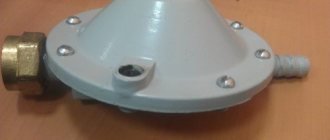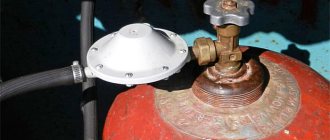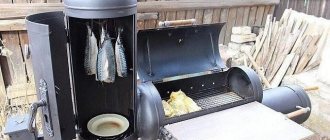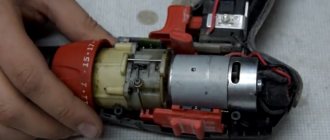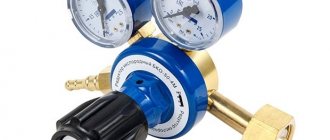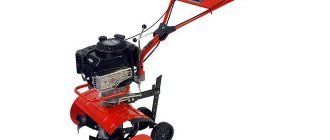Designed to reduce and automatically maintain within specified limits the pressure of liquefied hydrocarbon gas vapors taken from cylinders with a valve. Applicable to all propane cylinders, regardless of volume.
Explanation of markings: RDSG - liquefied gas pressure regulator, 1 - for cylinders with a valve, 1.2 - volumetric gas flow rate in m³/h.
A frog for a gas cylinder is one of the most common types of gas reducers.
A gas cylinder reducer is a pressure stabilizer and is often an indispensable part of gas equipment. The pressure in a gas cylinder is not a constant value and depends on many factors, such as the fullness of the cylinder and its temperature, the type of filler gas and others. For normal operation of most devices, a certain set pressure is required. To match the gas pressure at the outlet of the cylinder and the pressure at the inlet to the device, a gas reducer is used. Gas reducers differ in the following indicators:
- highest throughput;
- the highest gas pressure at the inlet to the device;
- highest operating pressure at the outlet;
- according to the type of gas for which it is intended.
All this data is indicated in the product passport and must comply with GOST standards.
Please note that gearboxes for flammable and non-flammable gases have different thread directions and colors. In addition, when choosing a gearbox, you should ensure that its throughput is sufficient for the normal operation of connected devices and equipment.
How does a frog fit on a gas cylinder?
The frog reducer for a gas cylinder has a structure typical for this type of device. The operating principle of the gearbox is based on the counteraction of the pressure of the membrane and the spring. Depending on the spring and diaphragm characteristics, gearboxes will have different inlet and outlet pressures and therefore different applications.
Some types of gearboxes may have an additional device for adjusting the pressure level in the gearbox, but the “frog” is not equipped with these parts and is an unregulated gearbox.
Gearboxes of this type are widely used due to their simplicity and reliability, as well as low price. They are required to be equipped with propane cylinders for household use; they are included in automotive gas and gasoline equipment, heating and welding equipment, as well as in industry and production.
How to set up a frog gas reducer? Is the frog reducer for a gas cylinder repairable?
To set up and adjust the frog gas reducer, you need certain skills and experience. Without proper qualifications, it is undesirable to perform such procedures, as this may negatively affect the stability of the device, its reliability and safety. After setting up the gearbox, it is necessary to check its tightness and regularly monitor it subsequently.
The consequence of a breakdown or incorrect adjustment of the gearbox is the occurrence of a leak. The cause of depressurization of the device may be failure of the membrane, valve or spring.
Only a dismountable, leaking frog reducer for a gas cylinder can be repaired. In this case, it is possible to both replace damaged parts and adjust them using gaskets. However, often the resulting effect will not last long and will not be worth the effort.
A frog-type reducer for a gas cylinder is an inexpensive and reliable device necessary for the safe and comfortable operation of gas equipment.
The gas in the cylinder is in the form of a liquid; it turns into a gaseous state and is supplied to the gas equipment through a valve.
The pressure in the tank is significantly higher than what is required for consumers. To reduce and stabilize it, a simple and useful device is used - a propane reducer, or adapter.
The device of the frog gas reducer, its specific differences
A frog for a gas cylinder is one of the most common types of gas reducers.
A gas cylinder reducer is a pressure stabilizer and is often an indispensable part of gas equipment. The pressure in a gas cylinder is not a constant value and depends on many factors, such as the fullness of the cylinder and its temperature, the type of filler gas and others. For normal operation of most devices, a certain set pressure is required. To match the gas pressure at the outlet of the cylinder and the pressure at the inlet to the device, a gas reducer is used. Gas reducers differ in the following indicators:
- highest throughput;
- the highest gas pressure at the inlet to the device;
- highest operating pressure at the outlet;
- according to the type of gas for which it is intended.
All this data is indicated in the product passport and must comply with GOST standards.
Please note that gearboxes for flammable and non-flammable gases have different thread directions and colors. In addition, when choosing a gearbox, you should ensure that its throughput is sufficient for the normal operation of connected devices and equipment.
Classification depending on the scope of application
Depending on the scope of application, reducers for gas cylinders are divided into several types:
- Household unregulated.
- Universal adjustable
- Professional.
Household unregulated
This type includes the simplest gearboxes used in domestic gas supply to households and in camping conditions. RDSG reducers are installed together with household gas cylinders. They have the simplest design, allowing the use of gas only in household stoves and are inexpensive and reliable. The frog reducer for a gas cylinder, or RDSG-1, is used in conjunction with containers from 12 to -50 liters.
For five-liter gas cylinders, popular among summer residents, tourists and hunters, the RDSG-2 Baltika model is used. The Baltika reducer is put on the nipple of the gas cylinder from above and fixed in the rubber seal with a special clamp. The gearboxes are configured for an operating pressure of 0.3 MPa and a throughput of 1.2 m 3 / hour
Universal adjustable
This class of gearboxes has a more complex design and wider capabilities. They can already be used both for domestic gas supply and for work in a home workshop. These reducers have a mandatory threaded connection to the gas cylinder, which securely locks the device.
Universal adjustable for propane with pressure gauge
They are also equipped with a pressure gauge and an adjusting screw that allows you to change the operating pressure from 0 to 0.3 MPa, depending on the needs of the gas consumer device connected to them. These devices also have a greater throughput than household ones - up to 5 m 3 / hour
Professional
This class is characterized by the use of more wear-resistant materials and better build quality and adjustment. The operating pressure adjustment parameters are also wider – from 0.4 to 1.6 MPa.
Professional gearbox with two pressure gauges
Some models are equipped with two pressure gauges - for inlet and operating pressure, respectively.
Pressure regulator RDSG 2-1.0 "Baltika"
By design, Baltika type regulators are direct-acting. They are simple and easy to use. They should be purchased separately, unlike valves that are pre-installed on cylinders and sold together with them. For several replaceable cylinders, it is enough to have one regulator (Fig. 1-10-3a).
Rice. 1-10-3a. Gas pressure regulators RDSG 2-1.0 (Baltika) with a valve on the cylinder:
1 - handle; 2 - fitting; 3 - rubber sealing ring; 4 - valve; 5 — threaded bushing of the cylinder;
The regulator is connected to household gas appliances using a rubber-fabric sleeve with an internal diameter of 10 mm.
When installing the regulator on the valve, the tap handles of the household gas appliance (most often a gas stove) connected to the regulator are set to the “Closed” position. The rubber-fabric sleeve connecting the household gas appliance to the regulator is pressed onto the regulator fitting with a metal clamp.
The regulator handle is turned to the “closed” position and the regulator is placed on the valve of a cylinder filled with gas. To do this, cover the regulator with your palms and press the plastic ring up with your fingers, place the regulator on the valve, lower the ring with force until it stops so that the balls move and catch on the protrusion on the valve. In this case, there must be a rubber sealing ring between the regulator and the valve.
The regulator handle is moved to the “Open” position (the image of the flame on the handle will be on top) and the tightness of the connection between the regulator and the rubber-fabric sleeve and the valve is checked by washing.
If there are no leaks, open the tap and light the burner of the gas appliance.
After the operation of the gas appliance ends, the handles of the regulator and taps are moved to the “Closed” position. During long breaks in use (more than 4-5 hours) of a gas appliance, the regulator handle is moved to the “Closed” position (with the taps of the gas appliance closed).
To remove the regulator from the cylinder valve, press up the plastic ring and lift the regulator by the body.
If the regulator is inactive for a long time, it is better to disconnect it from the cylinder valve, move the handle to the “Open” position, and lightly lubricate the balls.
If washing shows a gas leak from under the regulator, then its handle is moved to the “Closed” position (with the gas appliance taps closed) and the regulator is removed from the valve. Then take the cylinder with the valve out of the room and repeat washing the valve itself. If a gas leak is detected from the valve, you should call a specialist or, taking precautions, deliver the cylinder with the valve to the charging point.
- use a faulty regulator and repair it yourself; install the regulator on the valve and remove it if the handle is in the “Open” position and the taps of household gas appliances are not closed (in the “Open” position, the protruding rod of the regulator will press on the valve locking device, and gas will escape into the room);
- mount the regulator on the valve if there is no rubber sealing ring between them, and if there are circular holes or cracks on the ring;
- carry out independent valve repairs even on an empty cylinder, as residual gas vapors will be released from it.
Source
Features of using composite gas cylinders
Composite gas cylinders have recently become increasingly popular. This is due to their advantages over their steel counterparts.
- Weight. Almost twice as light as steel.
- Ease of handling. There are comfortable handles.
- Transparency. The fill level can be easily seen.
- Convenient storage. Can be placed one on top of the other and stacked.
- Life time. The service life is practically unlimited.
- Operational safety. It is caused by the absence of sparking and a safety valve and fusible link built into the gas cylinder.
Composite cylinders supplied to the Russian market are produced in the Czech Republic, Norway and India. When purchasing such a cylinder, it is necessary to clarify the connection standard. If the gas cylinder is equipped according to the Russian standard, you can use a regular reducer for the gas cylinder. If the gas cylinder comes with a European connector, then you will need to either order an adapter or purchase an imported reducer. Please note that each additional connection increases the risk of gas leakage.
Gas reducer malfunctions, repairs
Malfunctions of the gas reducer can be associated with a discrepancy between the pressure rating of propane or the gas mixture at the outlet, leading to deformation and damage to the internal elements of the regulator: membrane, spring, end of the bypass valve and gas leakage.
Naturally, determining the cause of the malfunction will require certain knowledge and skills. You can find out the cause of the malfunction and carry out independent repairs by disconnecting the fittings and disassembling the regulator body.
Let us tell you that to determine the pressure level it is recommended to use the following parameters:
- reducer diaphragm dimensions
- type and characteristics of the reducing spring
- mechanical force to close the bypass reducing valve.
Let us tell you that the “frog” reducer is an unregulated pressure option. More complex reduction systems are used for customized automotive systems.
membrane replacement
The NZGA RDSG-1-1.2 gearbox diaphragm is a round liner made of oiled rubber-fabric oil- and petrol-resistant fabric with a thickness of δ=3 mm, secured along the circumferential markings by the housing cover.
A possible cause of the defect is a violation of the tightness between the membrane and the housing. The malfunction is eliminated to create a better fit of the membrane by lubricating the edge of the lower housing with sealant. The above-membrane part of the body has an upper hole that provides communication with the environment.
replacing the reducing spring
The reducer for gas cylinders uses a long 1st degree reduction spring with parameters D=15.5, d=1.4, number of turns 12-14, balancing the force of the membrane and inlet valve in operating condition.
There are several reasons for the malfunction of the reducing spring: it broke, lost its elasticity, or stretched during operation.
It is recommended to replace the spring or install a gasket of appropriate thickness under it. Replacing the gear spring, as well as replacing the gasket, is not difficult.
What is a propane reducer?
The design of all propane reducers is very similar. They all have:
- Sealed housing made of aluminum, brass or plastic.
- Inlet pipe for connection to the cylinder.
- Outlet pipe for connection to the consumer.
- High and low pressure chambers.
- Flexible membrane.
- Valve and stem.
- Return spring.
- Working spring.
In professional gas reducers, a pressure gauge, an adjusting screw or flywheel, and a threaded connection of the supply pipe are added to the design. The gearbox housing has a cylindrical shape, which is due to the use of a round membrane that bends inside the operating pressure chamber. The inlet and outlet pipes protrude from the housing.
How to choose a propane reducer model?
Mandatory conditions for the industrial production devices under consideration must be:
- The presence of a metal cover that fits tightly to the body.
- Indelible marking indicating the pressure parameters for which the device is designed.
- Universal connection nipple for commonly used hose diameters (6.3 mm, 9 mm).
- Tight fit of all sealing parts (gaskets) to the corresponding surfaces. Usually, to check this, use a soap solution, when applied to the surface, no air bubbles should form
- Brass body (steel is prone to rust).
- Convenient handwheel for moving the adjusting screw.
- Spare gasket (optionally, an adapter for propane cylinders of European standard, Swedish or Norwegian production can also be included).
- Compliance with domestic safety standards - GOST 12.2.052 - 81.
In the process of choosing the standard size of a propane reducer, the permissible level of external temperatures at which its use does not pose a danger to others is also taken into account. Typically, the climatic class of these devices is UHL2, which allows the use of the gearbox in the temperature range of -25...+50°C. For the UHL class (temperate zone), the corresponding range is -15...+45°C. The coefficient of unevenness of the transmitted pressure should not exceed ±0.15.
The external condition of the device is also important for the possibility of using the gearbox. The body of the propane gearbox should not have surface dents or scratches, not to mention changes in shape. The same applies to the condition of the control pressure gauge. Before installing it in a stationary state, the pressure gauge should be checked for serviceability by supplying compressed air: if the instrument pointer is motionless, the gearbox cannot be used.
The purchased device must be fully consistent with the technical characteristics of the unit for which it is intended. In particular, gas consumption cannot exceed the operating characteristics of the gearbox. If the pressure at the outlet of the gearbox exceeds (compared to the nominal values), the automatic control of the main equipment, as a rule, fails, and the equipment itself is switched off. The limit values of the pressure used should not exceed the permissible values for equipment of this class by more than 10%. The device must have a certificate of conformity in Russia.
How to choose a reducer for a household propane cylinder
To select a propane reducer for a gas cylinder, it is necessary to study and compare their characteristics. The most significant are:
- Purpose.
- Maximum inlet pressure, kg/cm3.
- Working pressure, kg/cm3.
- Maximum gas consumption, m 3 /hour.
- Connection standard.
- Planned service life.
- Price.
Depending on the planned application and the planned type of cylinder, one or another model may be the best choice. So, for example, if you plan to connect a tabletop gas stove in a garden house that you visit on weekends (or take it on a boat trip) and estimate your monthly gas consumption to be five liters, a five-liter cylinder and a Baltika RDSG-2 gas reducer are best suited.
What pressure should be in a 4th generation gas reducer?
The theory says that, regardless of what kind of gearbox you have (vacuum gas gas 2 gearbox or electronic gearbox of the 4th generation), the pressure entering through the line for the propane-butane mixture is 12-16 atmospheres, for methane - 200 atmospheres. The outgoing pressure at the reducer is 1 atmosphere.
Interesting materials:
How to choose a hood for a small kitchen? How to choose a soldering iron tip? How to choose the stiffness of a hockey stick? How to choose toothpaste for sensitive teeth? What is the election procedure in the USA? Which wireless headphones for sports should you choose? What perfume to choose for autumn? What perfume to choose for the winter? What factors are considered abiotic? Select three correct answers out of six? What functions do proteins perform in a cell? Select three correct answers?
Precautionary measures
Household gas is very dangerous. The main threats posed by propane are:
Reminder about domestic gas
- Fire hazard.
- Unsuitable for breathing.
- Explosion hazard when the maximum concentration of propane in the air is reached, as well as when the temperature in a closed volume rises sharply.
- During a gas leak, the temperature drops sharply and frostbite is possible.
To preserve the life and health of people and their property, precautions should be taken:
Rules for using gas
- Avoid proximity to open flames and heat sources.
- Avoid the presence of other flammable materials in the work area.
- Eliminate the presence of nitrates and perchlorates near gas equipment due to their chemical activity.
- Do not use the reducer for a propane cylinder if it is damaged or leaking.
Design features and maintenance
According to their design, gearboxes differ into direct and reverse acting devices. The differences between them are in the design details, the performance characteristics are identical.
Design of gearboxes for a gas cylinder
In addition, gas reducers are used in single-stage and two-stage types. In single-stage, the pressure is reduced in one stage. In a two-stage reduction, the reduction is carried out in two steps. Balloon single-stage reducers are most widely used due to their reliable design and ease of use.
Diagram of direct and reverse acting devices
Direct-type devices have the following operating scheme: propane entering the high-pressure zone presses the valve away from its seat. Propane enters the working chamber, filling it and increasing the pressure in it. It acts on the membrane, compressing the main spring. The membrane goes down, pulls the stem and closes the valve when the operating pressure value is reached. During the use of propane, the pressure in the working chamber drops, high-pressure propane opens the valve again and gas enters the working area again.
Direct action gearbox diagram
In reverse type devices, the valve is opened by the main spring, overcoming the force of the high pressure gas. After the working area is filled and the pressure reaches the set value, the rod moves down, closing the valve. As propane is used, the pressure in the working area decreases and the spring opens the valve again.
Reverse gearbox diagram
Reverse-acting devices are considered more reliable and safe. They have gained popularity in household and professional applications.
How does it work?
Gas is pumped into cylinders under high pressure or liquefied so that as much of it as possible fits into the container. For welding and other purposes, propane is needed at much lower pressure, supplied at a constant rate. For this purpose, a reducer is placed on the cylinder . It lowers the pressure to working pressure and ensures its uniform supply.
In the chamber, inside the housing, there is a membrane, adjustable with a screw. It is pressed on one side by the gas coming from the cylinder. When the membrane is displaced under gas pressure, a passage opens into the second part of the chamber, where operating pressure is created.
Based on the operating principle of the membrane, a distinction is made between direct and reverse reduction methods.
Straight
With direct reduction, gas from the cylinder enters the first chamber and presses the membrane . Through the resulting gap, propane passes into the working space of the gearbox. When the required pressure is created in it, the membrane is installed in place and blocks the flow of gas. Propane leaves the working chamber, the pressure decreases, and again the gas from the cylinder opens the entrance. Gradually, equilibrium is established and a constant gap remains between the chambers.
Back
During reverse reduction, the membrane is initially open and gas from the cylinder freely flows into the working half of the chamber . After reaching the desired pressure, he presses the membrane and closes it.
On gas reducers for liquefied propane cylinders, the reverse reduction method is generally installed. It provides a stable gas supply at a uniform speed. Setting the required pressure on this design is easier and faster.
Carbon dioxide reducers for semi-automatic machines use direct reduction. The pressure decreases mainly due to the difference in the sizes of the chambers. There is only one pressure gauge on such devices. It shows the outlet pressure. The adjustment occurs by changing the size of the transfer channel.
The oxygen reducer for an oxygen cylinder has two pressure gauges or a rotameter instead of the second one installed at the outlet . They show the pressure in the cylinder and the rate of consumption or pressure in the working chamber.
Typical faults and their repair
Deviation of the operating pressure from the specified one can be caused by the following reasons:
- Spring breakage or displacement.
- Depressurization of the housing.
Gas leakage is caused by:
- Membrane damage.
- Depressurization of the housing.
- Valve failure.
Some gearboxes are made collapsible. They are, in principle, available for self-repair. Non-separable gas reducers, of course, in the event of a malfunction must be replaced entirely.
Important! Remember that when disassembling the gearbox, you accept full responsibility for the consequences of its use.
So, for example, a home craftsman who has basic plumbing skills is quite capable of replacing a spring or membrane in an unregulated “Frog” gas reducer. A housing with a damaged seal cannot be repaired. In this case, the entire device will have to be replaced.
After replacing damaged parts with new ones from the repair kit and assembling the gas reducer, it is necessary to check its tightness using a soap solution.
Periodic inspection and service work
The instructions for gas equipment require that the verifications specified in the passport be carried out regularly, even if welding and other work is carried out periodically.
Once a quarter the gearbox is purged - safety valve test . Equipment requires service once every six months. The membrane is checked and replaced every 5 years. Every day, before work, you should check the tightness of all connections. Apply soapy water to all joints.
System connection standards
Devices that support two standards for connecting the reducer to a gas cylinder are widespread:
- GOST - common in the CIS countries, used on locally produced steel cylinders.
- GLK is a European standard, used primarily on composite cylinders.
Connecting the reducer to the gas cylinder
To connect the working pipe:
- Threaded connection.
- Nipples 6.3 or 9 mm.
- Universal nipple.
- GLK.
Some gas reducers, for example, RGDS, are equipped at the factory with a 9 mm nipple pressed into the housing.
Reducers with adjustable operating pressure are equipped with a threaded half-inch outlet, which can optionally be secured with a union nut and a universal nipple.
It is safer to use devices that match the standard. Each adapter is an additional connection that increases the risk of gas leakage.
Installation and configuration of the gearbox
Installation of the gearbox is carried out only by specialists . You can regulate the operation of the device yourself if you strictly follow the instructions.
Cylinder reducers are mounted on the cylinder body. The regulator attaches directly to the outlet via an adapter. The degree of tightening of the screw on the adapter ensures sealing. A flexible gas hose no longer than 3 m . The hose is connected to the stove or boiler.
ValeraVoice of a construction guru It is prohibited to splice, pinch or twist hoses. You can only use special products; water or oxygen models are not suitable.
System connection standards
Connection of the device is regulated by 2 standards :
- GOST – used in the CIS countries, designed for steel cylinders;
- GLK is a European standard, used for the operation of composite cylinders.
Some gearbox models are equipped with a 9 mm press-fit nipple. This makes installation easier.
Adjustment
Adjustment of the gas reducer is only possible on models equipped with an adjusting screw or flywheel . In this case, the compression force of the spring acting on the membrane can be changed. In this way, the threshold pressure in the working chamber is reduced or increased. This changes the closing and opening parameters of the intake valve.
Adjustment is made by turning the nut . It is easier to do this if the cylinder is equipped with a pressure gauge on the working pipe: the pressure in the supplied mixture is reflected on the dial.
Installation and startup procedure
In order to ensure fire safety, the following procedure for installing and starting up the equipment should be observed:
- Carry out a thorough external inspection of the container, gas reducer and pipelines and ensure that there are no visible defects or excessive heat.
- Connect the reducer to the gas cylinder.
- Connect the consumer device to the gearbox
- Open the cylinder valve slightly and listen.
- Open the gearbox valve (if present).
- Open the valve of the consumer device and start using it.
If there is a whistling or clicking noise, immediately close the gas cylinder valve.
Sequence of installation and use
A propane reducer of any type and design is considered a high-risk technique, therefore, when installing it, a number of mandatory requirements must be observed:
- The room (if the gearbox is mounted to an internal consumer) is thoroughly ventilated. Moreover, the window/vent must remain open throughout the entire duration of the initial start-up.
- The correct sequence for using the device is as follows: first, the valve on the propane cylinder opens smoothly. Then the valve of the reducer opens and only then the valve of the gas-consuming equipment. By rotating the adjusting screw handwheel, the required level of operating pressure is set. Disabling is done in reverse order. When extraneous sounds appear - clicks, hissing, etc. - the equipment is immediately turned off.
- After establishing a stable flow of gas through the reducer, monitor the readings of the pressure gauge needle, which should not deviate more than the pressure fluctuation values indicated in the passport. Otherwise, the use of the technology is stopped. A slow increase in gas pressure is considered especially dangerous.
- Once every 2...3 months, the tightness of all connections is checked, and if necessary, the threaded fasteners are tightened.
- If routine maintenance of the propane reducer is necessary - purge the valve - the device is disconnected from the gas main, after which the remaining gas is released from all working cavities of the device. All subsequent operations are performed only in special workshops that have test benches.
- After finishing use, the inlet valve on the gearbox is closed all the way. In this case, the binding of the spring is eliminated, and its performance increases.
- To comply with fire safety rules, it is advisable to provide flame extinguishing devices between the gearbox and the gas-consuming installation.
https://youtube.com/watch?v=lspIr9UNH7E
The use of bottled gas requires a thorough approach to ensuring safety and ease of use. We propose to consider the simplest example of connecting a propane cylinder to a gas stove: connection diagram, shut-off and control valves, organization of storage conditions.
Required pressure and volume
The key characteristics of a gas reducer are inlet pressure, operating pressure and flow rate, or the maximum volume of gas passing through the device in an hour.
The inlet pressure is determined by the standard pressure in the cylinders and is usually 20 MPa.
Technical characteristics of gearboxes
The operating pressure for household unregulated gas reducers is set at 0.3 MPa ±5%
For adjustable semi-professional and professional adapters, the operating pressure is set by the user in the range of 0-0.4 MPa, and for certain high-performance models - up to 1.6 MPa
The consumption volume must exceed the volume consumed by the device (or group of devices) per hour.
pressure regulator "Baltika". what is the operating principle of the BALTIKA regulator?
Reducer type "RDG" Reducer type "Baltika"
Typically, the design of the pressure regulator allows a one-stage reduction in pressure to the pressure level of the gas phase of liquefied gas (2.5 - 5 kPa) at the outlet of the cylinder.
The design of gearboxes is almost universal, but there are still a sufficient number of non-interchangeable cylinder valves and gearboxes. Therefore, in our country, two types of gearboxes, “Baltika” and “RDG,” are accepted for use by the relevant standards. This is due to the fact that in the cylinders used in Ukraine, either a valve is used as a shut-off valve, onto which an “RDG” type reducer is screwed, or a valve - in this case, a “Baltika” type reducer is used.
The principle used in all types of pressure regulators is as follows. 1 diaphragm; 2, 3 springs, respectively, regulator and return; 4, 10 holes, respectively, exhaust and inlet; 5, 6 caliper and diaphragm spindle; 7 lever; 8 building. 1 open switch /closed ; 2 outlet; 3 second stage diaphragm; 4 first stage diaphragm; 5 ball coupling.
A sensitive loaded diaphragm, under the influence of, on the one hand, excess pressure of the gas phase, and, on the other hand, a spring, opens or closes the valve inlet. The diaphragm is supported by a spring that regulates the pressure. Thus, the reducer can be adjusted to close at any pressure. Being adjusted to a certain output pressure, such a reducer will withstand it regardless of fluctuations in inlet pressure and changes in gas extraction.
Adjustable reducer for gas cylinder
Adjustable gas reducers operate on the same physical principles as non-adjustable ones and have a similar design. The difference is that the compression force of the reducing spring supporting the membrane can be changed using an adjusting screw coaxial with the spring in the simplest models, or using a flywheel and a more complex mechanical transmission.
Adjustable reducer for gas cylinder
The principle of operation is that by changing the pre-compression force of the reduction spring, the user changes the threshold gas pressure in the working chamber required to operate and close the intake valve. A pressure gauge is also added to the parts, installed on the working pipe and allowing you to visually monitor the result of the adjustment.
Comparative table of pressure regulators from different manufacturers, type RDSG-1
| Model | Inlet pressure | Outlet pressure | Gas consumption | Availability of adjustment | Availability of pressure gauge |
| RDSG 1-0.5 Belarus | 0.07-1.6 MPa | 2000-3600 Pa | 0.5 m3/hour | No | No |
| RDSG 1-1.2 | 0.07-1.6 MPa | 2000-3600 Pa | 1.2 m3/hour | No | No |
| Milano under eyeliner | 0.03-0.75 MPa | 1960-5880 Pa | 1.5 m3/hour | Yes | No |
| Milano under the sleeve | 0.03-0.75 MPa | 1960-5880 Pa | 1.5 m3/hour | Yes | No |
| Italy 694 | 1.6 MPa | 2900 Pa | 1.5 m3/hour | No | No |
| Italy 694 d/composite cylinders | 1.6 MPa | 3700 Pa | 1.5 m3/hour | No | No |
| RDSG 1-1.3 China | 0.07-1.6 MPa | 2000-3600 Pa | 1.3 m3/hour | No | Yes |
| RDSG 1-0.5 China | 0.07-1.6 MPa | 2000-3600 Pa | 0.5 m3/hour | No | Yes |
| GOK EN-61 | 1.6 MPa | 3700 Pa | 1.5 m3/hour | No | No |
| GOK for composite cylinders | 1.6 MPa | 2900 Pa | 1.5 m3/hour | No | No |
For normal operation of the equipment, the throughput or gas flow rate of the reducer must be 15-20% higher than the maximum consumption per hour.
The Trio-service company offers the best selection of household pressure regulators.
Source
General rules for choosing a balloon reducer
Summarizing the rules for choosing a gearbox for a gas cylinder, it should be noted that:
Classification of reducers for gas cylinders
- it is necessary to sketch out a diagram of the planned system from the gas cylinder to the end user;
- clearly formulate the following requirements for the device:
- Purpose.
- Operating pressure.
- Need for adjustment.
- Maximum volume.
- Method of connection to a gas cylinder and to a working device.
- Availability of maintenance and repair.
- Allotted budget.
- From the variety of products on the market, you should choose those that meet the stated requirements.
- Next, you need to enter the models and their characteristics into the comparison table and conduct a price analysis.
If devices that meet the stated requirements do not fit within the allotted budget, then it is necessary to either revise the budget or simplify the requirements for the device.
Pressure regulators for liquefied gases “frog”: everything from operating principle to choice
A gas reducer is an essential element of the gas supply system, well known to everyone who uses autonomous sources due to the lack of connection to a centralized main line. Regardless of its modification, the device takes on two functions simultaneously. It lowers the pressure and automatically maintains it at the required level at any intensity of gas consumption for stable and correct operation of the equipment - stove or heating boiler.
Propane in cylinders is at a pressure of 1.6 MPa or 16 bar. Typical operating requirements for consumer equipment range from 0.02 to 0.036 bar. Connecting directly is fraught with serious consequences, so purchasing and installing a gearbox is a safety issue and the very case when you should not skimp on small things.

